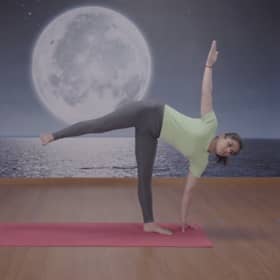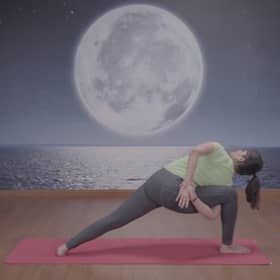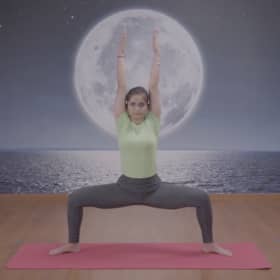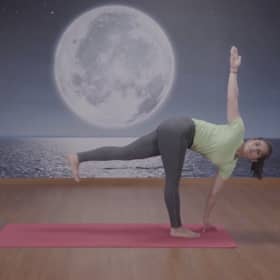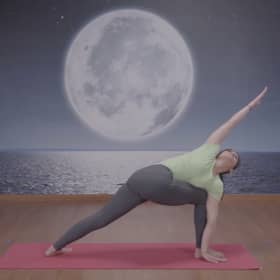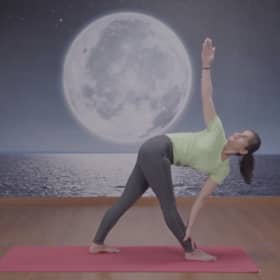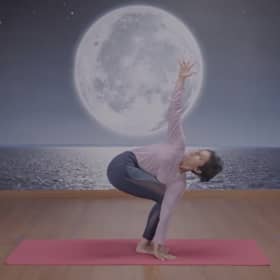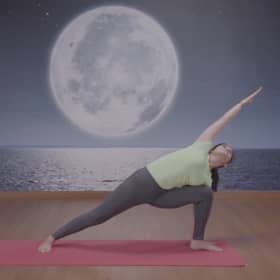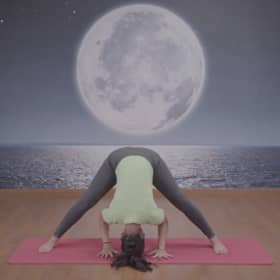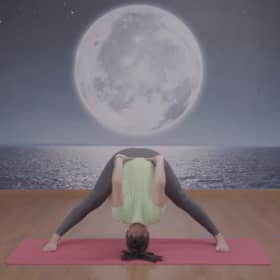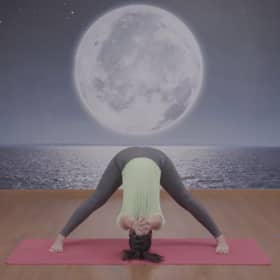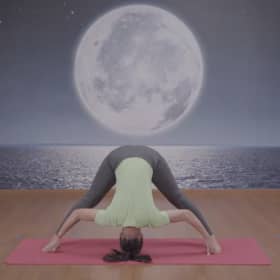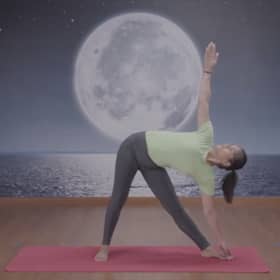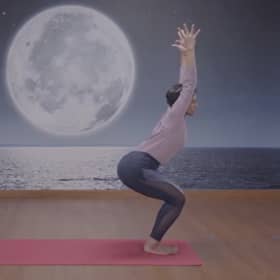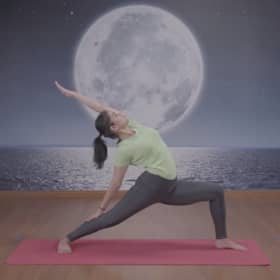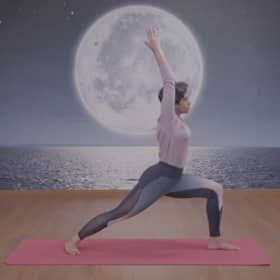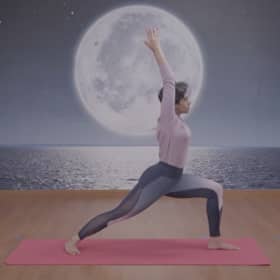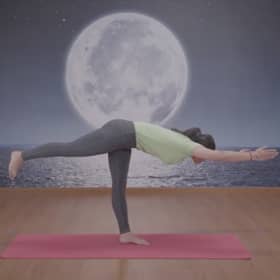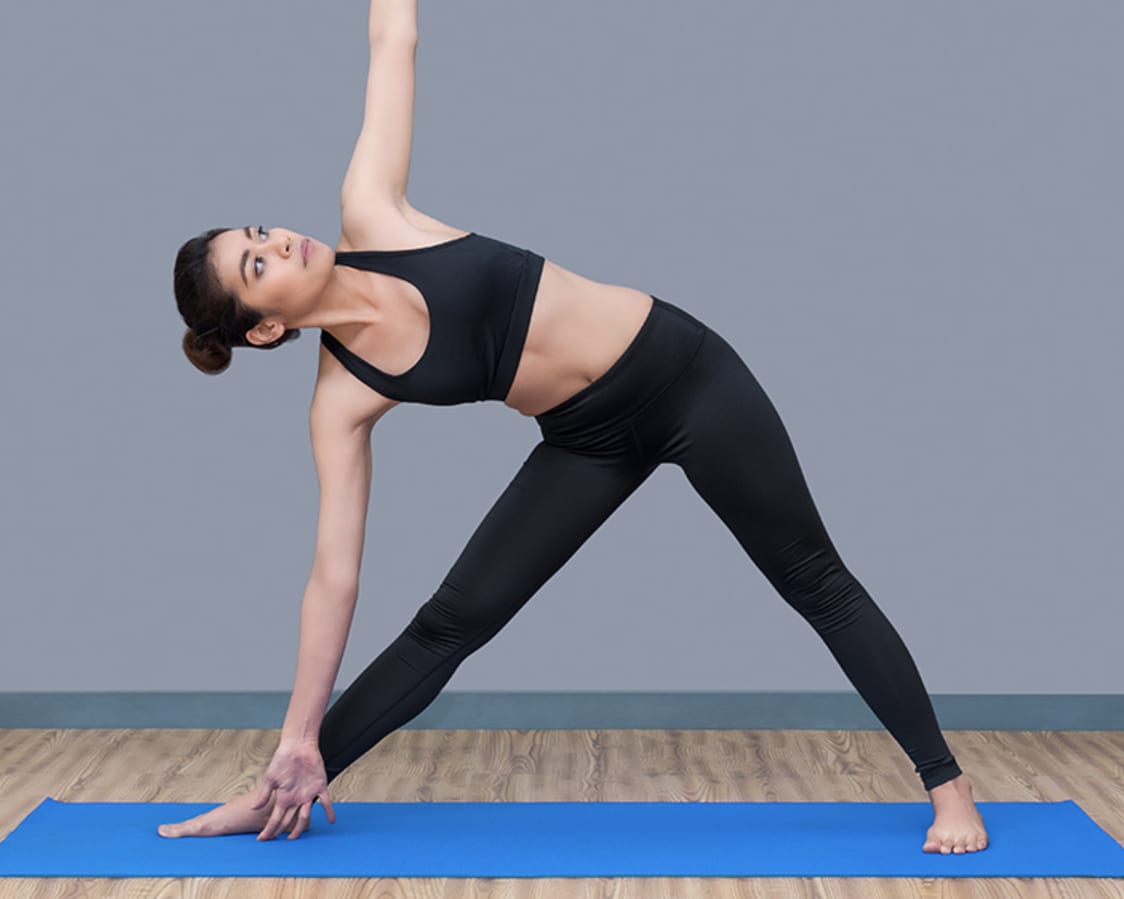
About this pack
18 Videos
What to expect from Standing Postures?
About Ardha Chandrasana: In the first session, we begin with Ardha Chandrasana or the half moon pose. This posture is known to improve coordination and balance in addition to improving digestion and working on the groin, hamstrings, calves, shoulders, chest and spine.
About other poses:
After this posture, our instructor will teach you how to do Baddha Parshvakonasana, a yoga posture that relieves stiffness in the back muscles, stretches the groin and tones the abdominal muscles. Some of the other standing yoga poses that we’ll be covering in these sessions include Kaliasana, Parivrtta Utkatasana, Parivratta Trikonasana yoga, 4 variants of Prasarita Paddottanasana, 3 variants of Virabadrasana others
When to perform these postures:
Since these yogasanas only require about a minute’s time, you can practise them all in one go. Now, getting the postures exactly right the first time could be challenging. We recommend that you practise these standing postures regularly. Also, you can perform these yoga postures any time of the day in the comfort of your home. Now, if you’re ready, let’s begin with the first session of this series.
What is standing yoga?
In the times like what we all are experiencing these days- times of informational chaos and expectations of balancing it all together, mindfulness can be of tremendous help. It not only helps in making you gentler with yourself but also in controlling spirals of emotions and increasing your willpower. Online Yoga Classes on the other hand is described as a union of the mind and the body. There is a lot that we know about the benefits of mindfulness and yoga separately. These benefits enhance manifolds when we combine the two. One of the best ways to practice mindfulness is through yoga and particularly standing yoga poses. These standing asanas in yoga (poses) form an important part of yoga for the many anatomical and therapeutic benefits that they have. Standing yoga poses soothe the nervous system, create a balance and focus in the mind, and have several health benefits.
What is a standing yoga workout?
Standing position asanas workout is a group of functional yoga poses that are done with one or both feet on the ground and an upright body position. This workout is a flowing sequence of movements rather than static poses. Standing yoga poses involve stretching and targeting specific spots in the body to build strength and flexibility.
How effectively can we do standing yoga poses at home?
Standing yoga poses can be done anywhere and anytime, including your home. All that you need is: A clean and airy corner in your house that’s free of distractions. If you are just starting with yoga, you can opt to learn standing yoga poses for beginners with a yoga trainer or an audio or video-based workout apps.
Who can do standing yoga poses?
Standing yoga poses can be done by anyone irrespective of their age, gender, and religion. You need to have a basic level of fitness and you are ready for the entire list of standing asanas!
Who should avoid standing yoga poses?
While yoga is for everyone, standing yoga poses should be avoided by people who have experienced these problems: Chronic pains in any parts of the body Pulled hamstring Shoulder injury Heart diseases Have just come off surgery of the eyes or for any other specific problems
What is the list of standing yoga poses with names?
While there are close to 100 standing asanas in yoga, here is a selective list of standing asanas for beginners and those who have intermediate and advanced knowledge of yoga. The standing list of standing yoga poses with names include: Standing yoga poses for beginners: Chair pose (Utkatasana) Downward facing dog pose (Adho Mukha Svanasana) Mountain pose (Tadasana) Standing yoga poses for the intermediate level: Big toe pose (Padangusthasana) Dolphin pose Eagle pose (Garudasana) Standing yoga poses for advanced level: One-legged headstand (Eka pada sirsasana) Lord of dancers pose (Natarajasana) Headstand (Sirsasana)
Standing yoga poses explained
Here is what you need to know about each standing asana in yoga. You can understand them better by studying standing asanas images with names. Standing asanas names for beginners explained with duration: Chair pose (Utkatasana): Stand in mountain pose, inhale on a count of 2 and raise your arms above your head and join your palms. Exhale on a count of 3 and bend your knees. Get your thighs parallel to the floor. Keep your lower back straight and lower your tailbone towards the floor. Stay in the pose for 15-30 seconds and release. Downward facing dog pose (Adho Mukha Svanasana) Bring your hands slightly forward of your shoulders and create a spiral action in your arms by rolling your upper arms away from your forearms. Tuck your toes under and on exhalation engage your lower belly by drawing the navel back to the spine. Press through your hands and lift your hips up to bring yourself in an upside-down V position. Slide your shoulder blades and spread your collar bones. Stay for 5 breaths and release. Mountain pose (Tadasana) Stand with the base of your big toes touching together and heel slightly apart. Lift and spread your toes and the balls of the feet and balance your weight evenly on the feet. Press your shoulder blades in the back and lift the top of your sternum straight towards the ceiling. Stay in the pose for 30 seconds-1 minute and release. Standing asanas names for intermediate level explained with duration: Big toe pose (Padangusthasana) Stand straight with your feet at least 6 inches apart. Bend forward and touch your forehead to the knees. Hold your big toe with your fingers. Inhale on a count of 3 and straighten your elbows and lift your torso. Exhale and release the torso and bend your toes. Dolphin pose Get onto all your fours and press your palms against the floor. Exhale and lift your knees and heels away from the floor slightly and balance your lower body. Extend your tailbone away from the pelvis and lift your body towards the sky and draw your ankles close to the pelvic region. Look downwards. Stay for 30 seconds and release. Eagle pose (Garudasana) Begin with the Mountain pose with your feet close together. Bend your knees a little and lift your left foot. While balancing your body on your right foot, cross your left thigh over the right thigh. Continue to balance and stretch your arms parallel to the floor. Cross the right arm over the left and bend your elbows. Curl your hands further so that the palms face each other. Stay in the pose for 15 seconds to 1.5 minutes and release. Standing asanas names for advanced level explained with duration: Headstand (Sirsasana) Kneel on the floor with your elbows apart by shoulder width. Touch the top of your head as you go upside down and tuck chin to chest. Lift your hips till your body forms an inverted V shape. Lift your feet off the mat one leg at a time. Hold the pose for 10-30 seconds and release. One-legged headstand (Eka pada sirsasana) Fold yourself forward and place your forehead on the mat. Keep your hands planted on the floor and rest your arms on the triceps. Inhale for 30 seconds and take one leg upwards towards the sky. Exhale and alternate with the other leg. Lord of dancers pose (Natarajasana) Shift your weight to the right foot and bend your left knee to lift the left foot off the floor. Hold the left foot with your left hand. Lift your right arm towards the ceiling. Lift your left leg behind you and bring your torso forward. Hold for 5-10 breaths and release.
What are the benefits of doing standing yoga poses?
Standing yoga poses have tremendous benefits for our health. These include: Standing yoga poses help in improving digestion and preventing gastrointestinal problems. They help in relieving headaches. Yoga balance poses are helpful for women who are trying to conceive. Standing yoga poses for beginners that have sitting yoga poses included like Surya Namaskar and pranayama for beginners help in getting the breathing rhythm correct and relieving stress and anxiety. They help in strengthening the wrists, ankles, back, toes, etc. Standing yoga poses help in toning calves, thighs, arms, etc. They help in improving the balance of the body and preventing falls. They are beneficial in correcting hormonal imbalances.
What are the disadvantages of doing standing yoga poses?
If not done correctly, standing yoga poses may cause some risks and disadvantages. These include: Standing yoga poses may cause injuries or increase the risks of injuries to the neck, wrists, back, etc. Certain standing yoga poses that require quick movements may cause internal injuries to the brain and other organs. People who suffer from osteoporosis may painful symptoms while doing standing asanas in yoga. Pregnant women may experience the contraction of the abdomen while doing standing asanas in yoga.
What are the dos and don’ts of standing yoga poses?
Here are some tips to follow for a great standing yoga poses workout: The best way to start is with an instructor. She/he will guide you through all standing yoga poses with names for you to gain knowledge about the benefits of each pose. The instructor will introduce you to all the standing asanas images with names and customise them for you. Always practice your list of standing asanas and be consistent. Here are some things that you should avoid: Do not try too hard in the beginning since this might lead to injuries. Always use good quality equipment to avoid injuries.
What are the things that are required for standing yoga poses if you are at home & the gym?
Whether you are doing your standing yoga poses at home or outside, these things are essential for a good workout: Yoga mat that has a comfortable texture. A good quality towel. Comfortable and breathable clothing. A bottle of water.
Top Searches
Weight Loss Exercise | Six Pack Abs | Cardio Exercises | HIIT Workout | Belly Fat Exercises | Exercise For Kids | Lean Muscle | Hrx Workout | Handstand Push Up | Online Yoga Classes | Gym Near Me | Online Fitness Trainer | How To Increase Stamina | Exercise for Beginners | Pilates Workout | Oblique Exercises | Dumbbell Exercises | Thigh Exercises | Abs Workout | Butt Exercises
Dentist Near Me | Gynaecologist Near Me | Dermatologist Near Me | Endocrinologist Near Me | Pulmonologist Near Me | Cardiologist Near Me | Orthopedist Doctor Near Me | Thyroid Test | Pregnancy Test | Full Body Checkup | Kidney Function Test | Therapist Near Me | Online Counselling | Physiotherapist Near Me

